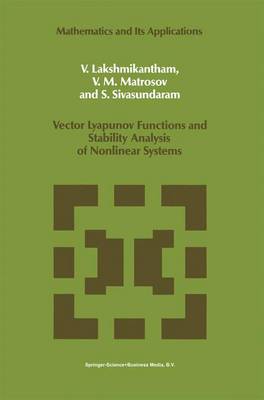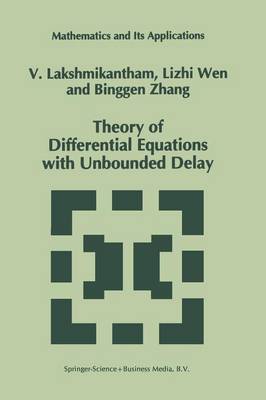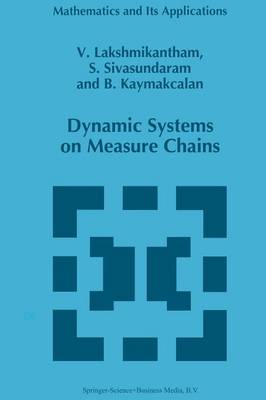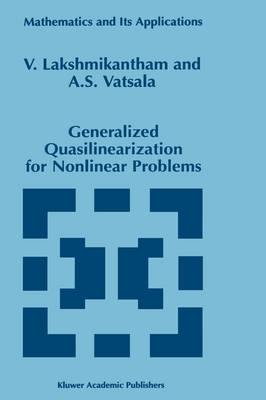Mathematics and Its Applications
5 primary works
Book 63
Vector Lyapunov Functions and Stability Analysis of Nonlinear Systems
by V. Lakshmikantham, V.M. Matrosov, and S. Sivasundaram
Published 31 March 1991
One service mathematics has rendered the 'Et moi, "', si j'avait su comment en revenir, je n'y serais point all".' human race. It has put common sense back where it belongs, on the topmost shelf next Jules Verne to the dusty canister labelled 'discarded non- sense'. The series is divergent; therefore we may be able to do something with it. Eric T. Bell O. Heaviside Mathematics is a tool for thought. A highly necessary tool in a world where both feedback and non- linearities abound. Similarly, all kinds of parts of mathematics serve as tools for other parts and for other sciences. Applying a simple rewriting rule to the quote on the right above one finds such statements as: 'One service topology has rendered mathematical physics ...'; 'One service logic has rendered com- puter science ...'; 'One service category theory has rendered mathematics ...'. All arguably true. And all statements obtainable this way form part of the raison d'etre of this series.
Book 298
Theory of Differential Equations with Unbounded Delay
by V. Lakshmikantham, Lizhi Wen, and Binggen Zhang
Published 31 July 1994
Because the theory of equations with delay terms occurs in a variety of contexts, it is important to provide a framework, whenever possible, to handle as many cases as possible simultaneously so as to bring out a better insight and understanding of the subtle differences of the various equations with delays. Furthermore, such a unified theory would avoid duplication and expose open questions that are significant for future research.
It is in this spirit that the authors view the importance of their monograph, which presents a systematic and unified theory of recent developments of equations with unbounded delay, describes the current state of the theory showing the essential unity achieved, and provides a general structure applicable to a variety of problems.
It is the first book that:
(i) presents a unified framework to investigate the basic existence theory for a variety of equations with delay;
(ii) treats the classification of equations with memory precisely so as to bring out the subtle differences between them;
(iii) develops a systematic study of stability theory in terms of two different measures which includes several known concepts; and
(iv) exhibits the advantages of employing Lyapunov functions on product spaces as well as the method of perturbing Lyapunov functions.
This book will be of value to researchers and advanced graduate students in mathematics, electrical engineering and biomathematics.
It is in this spirit that the authors view the importance of their monograph, which presents a systematic and unified theory of recent developments of equations with unbounded delay, describes the current state of the theory showing the essential unity achieved, and provides a general structure applicable to a variety of problems.
It is the first book that:
(i) presents a unified framework to investigate the basic existence theory for a variety of equations with delay;
(ii) treats the classification of equations with memory precisely so as to bring out the subtle differences between them;
(iii) develops a systematic study of stability theory in terms of two different measures which includes several known concepts; and
(iv) exhibits the advantages of employing Lyapunov functions on product spaces as well as the method of perturbing Lyapunov functions.
This book will be of value to researchers and advanced graduate students in mathematics, electrical engineering and biomathematics.
Book 370
Dynamic Systems on Measure Chains
by V. Lakshmikantham, S. Sivasundaram, and B. Kaymakcalan
Published 31 August 1996
From a modelling point of view, it is more realistic to model a phenomenon by a dynamic system which incorporates both continuous and discrete times, namely, time as an arbitrary closed set of reals called time-scale or measure chain. It is therefore natural to ask whether it is possible to provide a framework which permits us to handle both dynamic systems simultaneously so that one can get some insight and a better understanding of the subtle differences of these two different systems. The answer is affirmative, and recently developed theory of dynamic systems on time scales offers the desired unified approach.
In this monograph, we present the current state of development of the theory of dynamic systems on time scales from a qualitative point of view. It consists of four chapters. Chapter one develops systematically the necessary calculus of functions on time scales. In chapter two, we introduce dynamic systems on time scales and prove the basic properties of solutions of such dynamic systems. The theory of Lyapunov stability is discussed in chapter three in an appropriate setup. Chapter four is devoted to describing several different areas of investigations of dynamic systems on time scales which will provide an exciting prospect and impetus for further advances in this important area which is very new.
Some important features of the monograph are as follows:It is the first book that is dedicated to a systematic development of the theory of dynamic systems on time scales which is of recent origin. It demonstrates the interplay of the two different theories, namely, the theory of continuous and discrete dynamic systems, when imbedded in one unified framework. It provides an impetus to investigate in the setup of time scales other important problems which might offer a better understanding of the intricacies of a unified study.GBP/LISTGBP
Audience: The readership of this book consists of applied mathematicians, engineering scientists, research workers in dynamic systems, chaotic theory and neural nets.
In this monograph, we present the current state of development of the theory of dynamic systems on time scales from a qualitative point of view. It consists of four chapters. Chapter one develops systematically the necessary calculus of functions on time scales. In chapter two, we introduce dynamic systems on time scales and prove the basic properties of solutions of such dynamic systems. The theory of Lyapunov stability is discussed in chapter three in an appropriate setup. Chapter four is devoted to describing several different areas of investigations of dynamic systems on time scales which will provide an exciting prospect and impetus for further advances in this important area which is very new.
Some important features of the monograph are as follows:
Audience: The readership of this book consists of applied mathematicians, engineering scientists, research workers in dynamic systems, chaotic theory and neural nets.
Book 373
Nonlinear Integral Equations in Abstract Spaces
by Dajun Guo, V. Lakshmikantham, and Xinzhi Liu
Published 30 September 1996
Many problems arising in the physical sciences, engineering, biology and ap plied mathematics lead to mathematical models described by nonlinear integral equations in abstract spaces. The theory of nonlinear integral equations in ab stract spaces is a fast growing field with important applications to a number of areas of analysis as well as other branches of science. This book is devoted to a comprehensive treatment of nonlinear integral equations in abstract spaces. It is the first book that is dedicated to a systematic development of this subject, and it includes the developments during recent years. Chapter 1 introduces some basic results in analysis, which will be used in later chapters. Chapter 2, which is a main portion of this book, deals with nonlin ear integral equations in Banach spaces, including equations of Fredholm type, of Volterra type and equations of Hammerstein type. Some applica equations tions to nonlinear differential equations in Banach spaces are given. We also discuss an integral equation modelling infectious disease as a typical applica tion. In Chapter 3, we investigate the first order and second order nonlinear integro-differential equations in Banach spaces including equations of Volterra type and equations of mixed type. Chapter 4 is devoted to nonlinear impulsive integral equations in Banach spaces and their applications to nonlinear impul sive differential equations in Banach spaces.
Book 440
Generalized Quasilinearization for Nonlinear Problems
by V. Lakshmikantham and A.S. Vatsala
Published 31 May 1998
The problems of modern society are complex, interdisciplinary and nonlin- ear. ~onlinear problems are therefore abundant in several diverse disciplines. Since explicit analytic solutions of nonlinear problems in terms of familiar, well- trained functions of analysis are rarely possible, one needs to exploit various approximate methods. There do exist a number of powerful procedures for ob- taining approximate solutions of nonlinear problems such as, Newton-Raphson method, Galerkins method, expansion methods, dynamic programming, itera- tive techniques, truncation methods, method of upper and lower bounds and Chapligin method, to name a few. Let us turn to the fruitful idea of Chapligin, see [27] (vol I), for obtaining approximate solutions of a nonlinear differential equation u' = f(t, u), u(O) = uo. Let fl' h be such that the solutions of 1t' = h (t, u), u(O) = uo, and u' = h(t,u), u(O) = uo are comparatively simple to solve, such as linear equations, and lower order equations. Suppose that we have h(t,u) s f(t,u) s h(t,u), for all (t,u).




